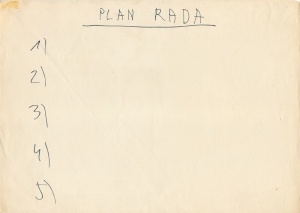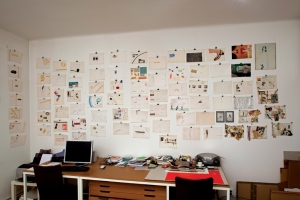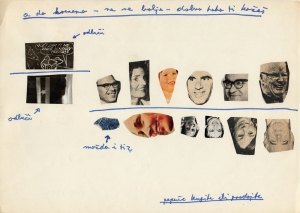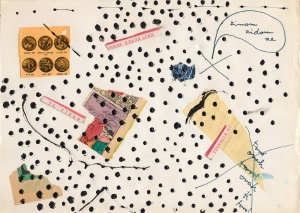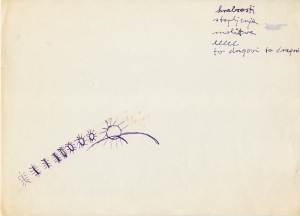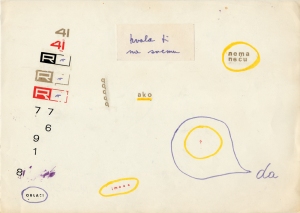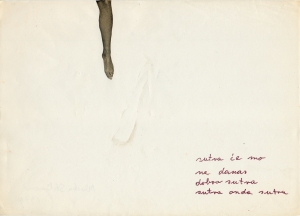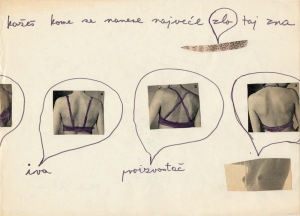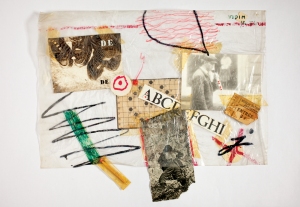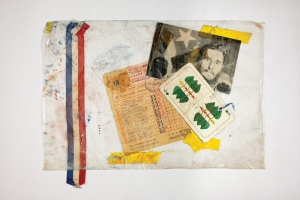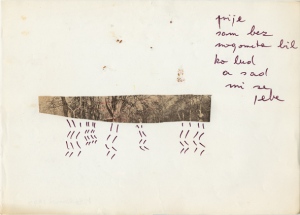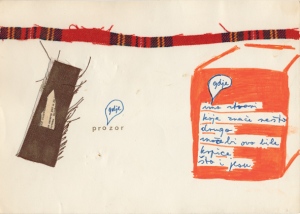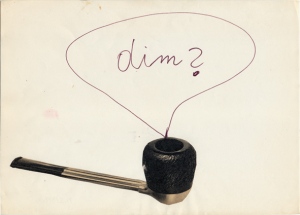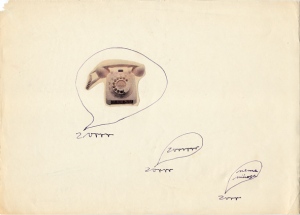EARLY DRAWINGS AND COLLAGES
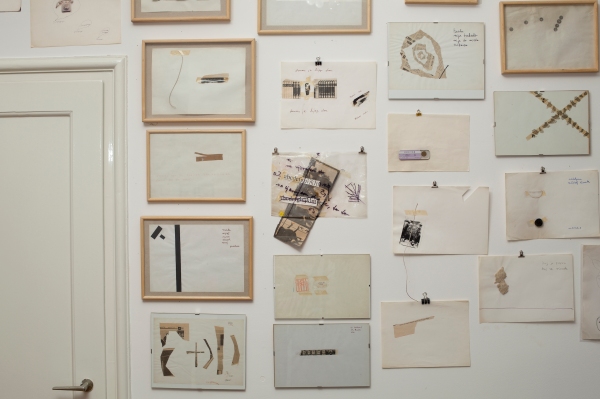
Early Drawings and Collages, installation view in the artist’s workroom, Zagreb, 2010
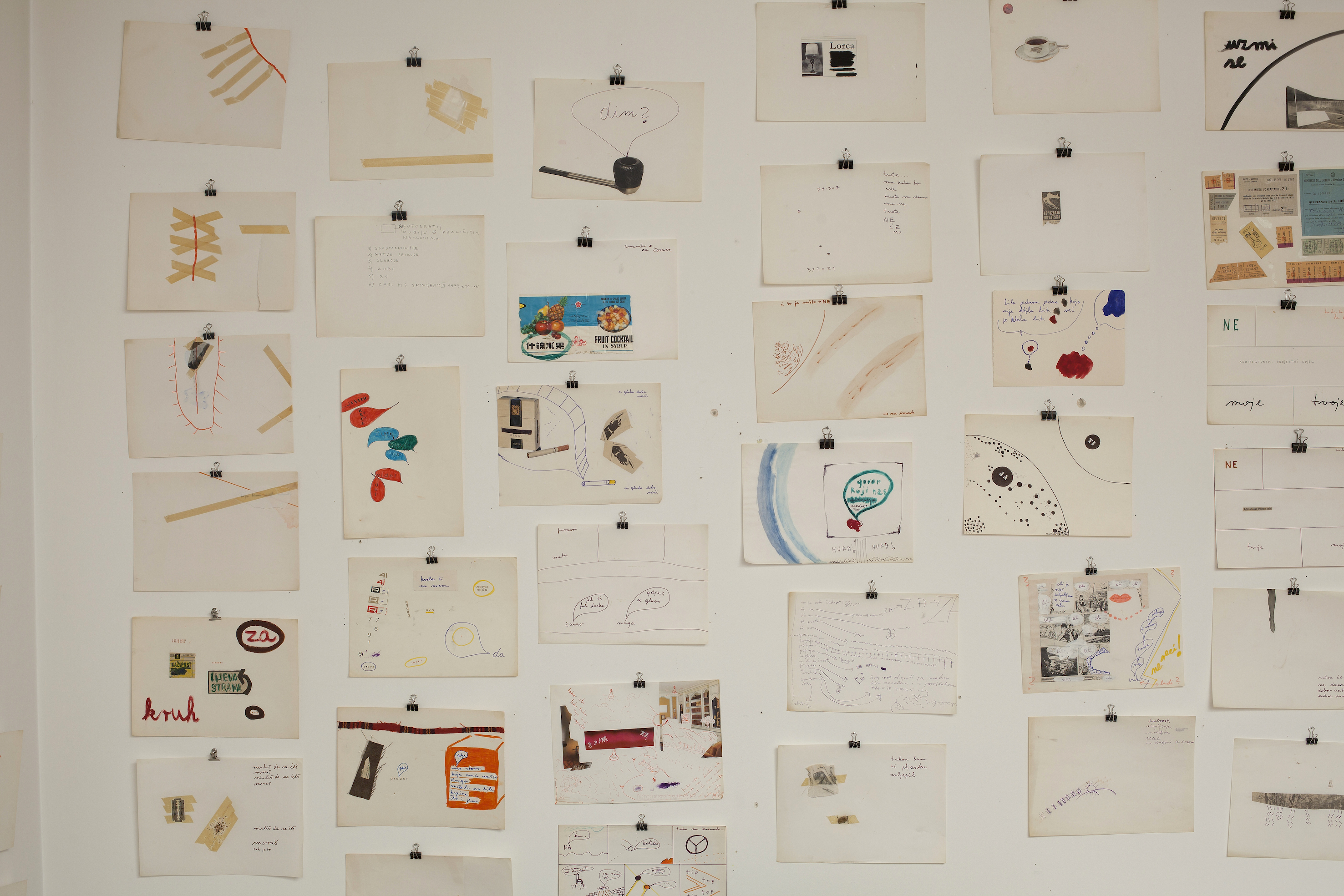
Early Drawings and Collages, installation view in the artist’s workroom, Zagreb, 2010
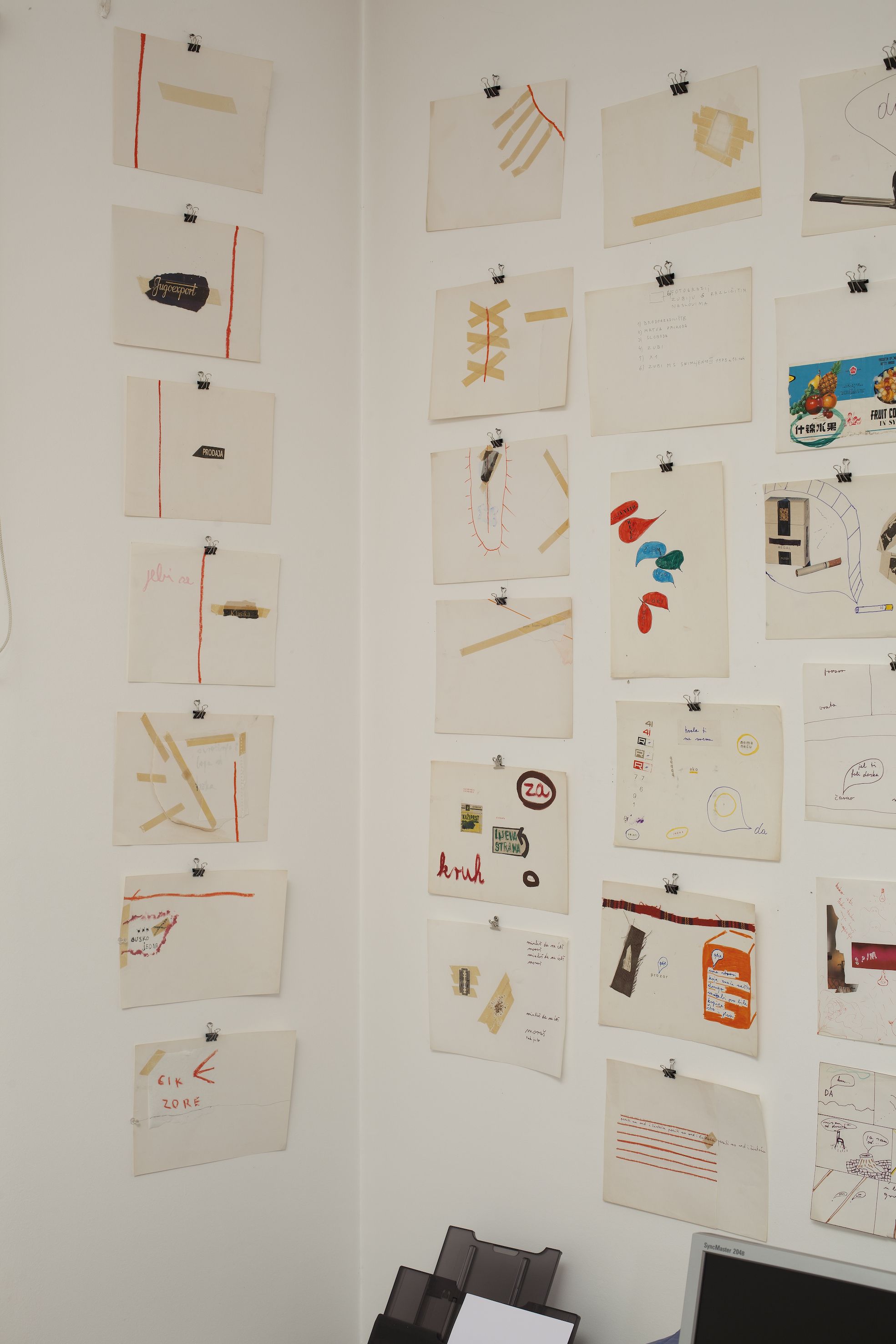
Early Drawings and Collages, installation view in the artist’s workroom, Zagreb, 2010
Whose burden
whose conscience
the image’s?
or
Daddy here are your socks
(Mladen Stilinović – Rani kolaži / Early Collages – 1972 – 1974 (ed. Branka Stipančić, texts by Ivana Bago, Boris Greiner, Nataša Ilić, Goran Trbuljak) Mladen Stilinović, Zagreb, 2015)
“Whose burden/whose conscience/the image’s?”: three lines of handwritten text in the upper-right corner of a sheet of paper. Pasted along its borders are images cut out from a magazine, showing details of naked female bodies – legs, breasts and torsos in black and white and in colour. And in the middle. . . a hammer. Drawn with a felt-tip pen, big and heavy, it is positioned in a discreet plane marked out with undulating bands of red/blue/red, like the outlines of a topographic map. This collage from 1972 is one of many produced during a period of a few years when Mladen Stilinović was still engaged in experimental filmmaking and before he started to exhibit as a visual artist. It forms a link between the poetry he had been writing in previous years and the visual language he was embarking upon. The piece also encompasses many elements of his later work such as simple execution, the use of found material and texts in a technique of collage, and handwritten texts as well as engagement with fundamental questions of artistic responsibility and existential anxiety and key concerns about the status of images, both those circulating in the media and directly appropriated, and those produced by recycling and recomposing of fragments of images taken from the media. Recurring subjects running through his work – poverty, pain, labour, art and responsibility – are often interconnected with seemingly absurd and banal statements, and sometimes even resolved through them.
‘Daddy here are your socks’ is a title cut out from a magazine that dominates a collage from the same period (1974). It includes other cut out words – ‘bread’, ‘water’, ‘night’, ‘clinic’ – a sequence that references a demand for sustenance, and points to themes of hunger, need, fear and illness. The words are combined with images also taken from magazines: a naked female body, a pig digging through the dirt, a flying object in space (a satellite?), an old house, sensual female lips in front of a mike and a pair of socks. From the sentence ‘Daddy here are your socks’, prominently placed just right of centre, a gentle female hand (Is it a hand that washes socks?) extends to offer a cocktail, under which ‘Letraset’ can be read. Obviously, there is a lot to unpack in this collage. The central statement ‘Daddy here are your socks’ could be understood as an absurd resolution of the mysteries ruling over everyday life (one of the most irritating being the eternal enigma of the disappearing sock), or as a laconic commentary on family and social authority and hierarchies (Which family? One that dwells in a mysterious house of which we know nothing? What has happened, or could have happened, in this house?). In this collage, as in many others, we find: a combination of words and images; the appropriation of verbal and visual statements; the use of materials from everyday life (matches, textiles, packaging, scotch tape, pins, etc.); and the recomposition of disparate fragments in new combinations done with a lot of humour and a flair for the absurd in relation to major themes. These are the main elements of Stilinović’s approach to collage, which for him is more than simply a technique – rather it is a central method of his thinking and work. Even when a piece is realised using other ‘techniques’, if you will, collagist thinking and the concept of montage remain crucial.
Collage as an artistic technique that unites different aesthetic approaches, and collage as a way of thinking that connects apparently disparate materials and thereby questions conventional artistic forms and the very definition of art, runs through Stilinović’s practice. Whether it figures as visual poetry or linguistic games composed of titles and texts cut out from newspapers and pasted or hand written, or as an intervention into material taken from newspapers and magazines, or as appropriation and re-composition of elements characteristic of street design, or what he calls ‘cardboard design’ (which refers to handwritten prices or announcements found in market stalls and public spaces in general), or as a collaging of advertisements, tickets, cut outs from ephemeral printed matter, and of objects from daily use (matches, thread…), collage is, as a rule, realised in a strict and simple way. Just as the language he regularly uses is unpretentious. But the results of Stilinović’s use of existing images, forms, materials and ideas are complex and multi-layered, enabling active interpretations and associations, and suspicious of immutable ideas and forms.
It is ‘poor art’, however the choice of simple materials is not defined by their functionality and availability. Instead it stems from a concept based neither in media nor (exclusively) in aesthetic considerations, but in a form of praxis – the unity of idea, material and action. For Stilinović, collage and the technique of montage are inscribed within the experience of the historical avant-gardes, where collage enabled a juxtaposition of signifiers and the confrontation of fragments of meanings that point to fields outside of art and stand in opposition to classical expectations of harmony, unity and the wholeness of the artwork. Stilinović’s collages from the early 1970s specifically refer to the ‘everyday’ of Yugoslav socialism. In his approach, the artist doesn’t use materials that are simply fragments of reality, but, as Benjamin Buchloch emphasised in the early 1980s in his analysis of the paradigmatic shifts of art emerging in the late 1970s,[1] Stilinović uses already-circulating cultural signs subjected to formal and linguistic operations that deconstruct the ideology of everyday life.
Stilinović takes experience of the everyday as the most common form of ideology in which the deepest social structures are reproduced as conscious life. His rethinking of the concept of the ‘everyday’ as a cultural category and as the place at which politics transforms the experiences and feelings of the ‘everyday’ is historically tied to the Russian avant-garde and related debates about cultural practices of resistance and the democratization of culture. This concept of the revolutionary transformation of social and cultural experiences and canonical forms of culture is produced in the context of a dialogue between art and social praxis in which art turns to everyday practices, partakes in networks of social reality and expresses its relation to extra-artistic forces. The Russian avant-garde placed the concept of the ‘everyday’ (byt) at the centre of a critique of culture, understanding culture as ‘everyday’ practice and ‘everyday’ practice as culture. Literary theorist Aleksander Flaker has defined this tension as follows: “Byt designates (…) the static nature of persisting aesthetic forms encountered in everyday life, but also of the social norms of everyday behaviour – ‘static’ as opposed to the dynamics of aesthetic redefinition of nature, ethics and social institutions.”[2]
This field, where everyday life resists transformation, is where Stilinović develops his artistic practice as a social one that rethinks the relations between a critique of the ‘everyday’ and a critique of social totality. “Whose burden/whose conscience/image’s?” is a question pertaining to the totality of his artistic practice seen as a form of everyday resistance that consciously or unconsciously broadens horizons and understands politics as a symbolic struggle in which social transformation is carried out on the level of images. Taking us back to the second collage, in this struggle over the symbolic, ‘socks’ stand for the ‘everyday’, banal to be sure, but is also a terrain on which social conflicts play out and which is defined by those very conflicts – however much official rhetoric aims to suppress them. Stilinović’s dealings with the ‘everyday’, with byt, in the collages he produced in the early 1970s already reveals a scope of themes he would elaborate on in his artistic practice in the coming decades.
There is an on-going discussion about at which moment Yugoslav socialism lost its organic ties to the principles of revolutionary politics established through the anti-fascist Peoples’ Liberation Struggle during World War 2, which affirmed new, egalitarian social relations and multinational politics. Events in the immediate post war years, specifically after the break with Stalin (1948) and the introduction of self-management (1950) resulted in significant economic growth, but by the mid-1960s the so-called market reform in 1965 marked the beginning of the transition to market socialism with the introduction of elements of a market economy and liberalization.
When Stilinović began his artistic work in the early 1970s, the Yugoslav economy, which had been increasingly integrated into the world market and subject to its fluctuations since early 1960s, was becoming more and more dependent on external flows and international aid; thus ‘self-management’ was losing its momentum, and the ‘conditions for the reproduction of capitalist relations were being established’[3]. The student movement and other intellectual, social, and political movements (under the strong influence of a dissident Marxist school of Praxis), which had protested against increasing inequality and the ‘red bourgeoisie’ in the late 1960s, were weakened under bureaucratic and police pressure, and a politics of the masses and of workers’ control was being replaced by the gradual formation of a professional political and economic class, with the accompanying growth both of consumerism and of economic difficulties. A dramatic increase in unemployment, debt and inflation outlined the crisis that over the next decade turned Yugoslavia into a periphery dependent on global capitalism. By the early 1990s, these processes culminated in the disintegration of the country through a number of wars. But in the early 1970s, when Stilinović started to produce his collages, the shape of the crisis was felt primarily as an erosion of trust in the emancipatory project of Yugoslav socialism and its promises of a free, just and equal society defined by a sense of social security. The strengthening of market relations, the growth of consumerism and the promise of consumerist welfare managed to postpone the confrontation with real social antagonisms (the entrenchment of class divisions; patriarchal heritage and a patriarchal understanding of gender roles; regional differences; antagonisms between the urban and rural population; the clash between intellectual and manual labour etc.) for a number of years, yet in the early 1970s the cracks were barely visible and the struggle for the realisation of socialist principles was not yet lost.
Nevertheless at that time, the discrepancy between the declared ideology of the party and state, and a social reality that clearly contradicted tireless proclamations of the full realisation of the principles of socialist self-government, had deeply compromised official discourse. The divergence between stated ideals and socialist reality in Stilinović’s early works focussed on the role of the image and media language in mediating cultural and social imagination. This found its expression in collage as a fundamentally ambivalent technique that enables critical reflection upon an alienated understanding of reality (ideology) and the articulation of alternative meanings, while simultaneously on the formal level it depends on materiality and a literal repetition of the gestures of consumerist culture. Stilinović appropriates and borrows authentic materials from reality, filtering and manipulating them to reveal new meanings, highlighting elements of mental play on the level of image and language, and underlining the tactile, physical enjoyment of handling materials, always with a dose of humour that accompanies his interventions. Collage and a method of montage provided an ideal medium for dealing with a culture saturated with images precisely because collage partakes in the culture it critiques, just like Stilinović’s critique of socialism was embedded in the official discourse of socialism, a language he then mobilized to reveal the contradictions that official rhetoric aimed to smooth over. Collage is appropriate for revealing social contradictions because it is not posited as a privileged point of critique outside the system, nor does it represent an exit from dominant social codes but is rather part of them.
Humour and irony characterise collage since its avant-garde beginnings. Through visual and verbal puns collage destabilises established notions and meanings and accepted divisions into ‘real’ and ‘false’ connections. Stilinović’s collages expose class divisions within a society that remained blind to them and hid from class struggle, and the works point towards the culturalisation of consumption and the commercialisation of culture against a non-problematized, allegedly unified field of working peoples’ culture with equal access for all, as well as to the gendered character of commercialised culture, against official proclamations of gender equality. In his analysis of the official discourse of the state and the party – which, with meagre skills yet great persistence kept announcing the successful achievement of communist ideals, as if blind to the lessons of social reality that revealed a rather different image – humour was Stilinović’s main tool, a kind of secret code and a point of identification of an assumed, hoped-for community.
His humour challenged the existing order in its use of collage for ‘alienation effect’ that would reveal weaknesses in the construction of the ‘naturalness’ of the ‘everyday’ and expose governing discourses as socially specific – expressions of the authoritarian imposition of particular interests as universal values. But Stilinović’s humour also carefully calculates the effects of its reception, and realises itself only through a reception that assumes that there is a community being formed through operations of humour. In that sense humour is a means through which Stilinović’s collages are artistic expressions of a commentary on hidden social tendencies, but also interventions into social reality – a contribution toward the establishment of a contra-public, acting out subtle pressure from below against bureaucratic repression and the real relations of domination. It is a play on a straight forward, directly democratic voice in a society in which sovereignty was realised dominantly as initiatives coming from above.
Mikhail Bakhtin’s interpretation of the dialogical nature of language and the production of meaning as the historical actualisation of a struggle between opposed social and political processes is crucial to Stilinović’s understanding of language and the principle of montage within his artistic practice. Collages use language and image to stage antagonisms refracted within broadly accepted, non-problematized meanings. Relying on different language registers; elements of trivial and vernacular culture; words from dialects, jargon and urban folklore; motifs from underground culture; disparate materials taken out of media circulation; as well as on garbage, detritus, and traces of consumerist culture (packaging, tickets, etc.) montage produces new constellations that are signs of social openness, but also of a fundamental opacity, of an unknowing of the ‘everyday’ that is longer taken for granted. Bakhtin’s understanding of laughter and parody as powerful sources of freedom, and as socially positive gestures of rebellious, carnivalesque subversion that pokes fun at the universalist pretensions of official language and culture is taken by Stilinović as a starting point from which a social core of humour as a creative and liberating rebellion against the dictates and norms of social life is made even more complex through a conscious take on aspects of the type of ribbing that aims to discipline by submitting members of society to the habits of their social environment. Stilinović’s humour takes into account both sides of the coin – it mocks power and partakes in forming a community of those who think differently, but it also taunts its own subjects, the artist included.
The complexity of Stilinović’s humour, which spares neither himself nor the community imagined through shared laughter and contempt for authority, consists in showing that the ridiculing of authority both critiques and also affirms the power of that same authority; this is what makes his humour specifically contemporary. In the conditions of late capitalism, humour is deemed a crucial and necessary expression of humanity. The optimism that humour allegedly expresses today is a social imperative. Humour is not just a way of releasing psychic tensions and escaping the limitations of life, nor is it only an expression of dissent against social demands and a tool for lightening stress and anxiety in brief moments of shared freedom; in our contemporaneous moment, it also contains a demand for the laying bare of accepted authority and the imperative of enjoyment in rebellion. In recent decades, submissiveness and the unquestioned acceptance of authority lost their privileged social status with the affirmation of neoliberal ideology in the last decades through the same process that the artistic model of work – characterised by the capability to develop and create projects, self-discipline, self-regulation, creativity, flexible and mobile living styles, etc. – became a model for a deregulated, flexible neoliberal labour market in which individuals are asked to manage their lives as business enterprises. Such a model, of course, calls for tireless optimism and permits a benign space for amusing and witty rebellion so long as it is accompanied by a necessary and healthy dose of humour. Already in 1977 Stilinović produced a series of photographs entitled ‘Artist at work’, which shows the artist while sleeping (and as the title suggests, working while sleeping). In later years, this work became a canonical image of post-Fordist transformation, in which the figure of the artist became a role model for reconfiguration of the field of work as place of ‘freedom’, with divisions between work and leisure abolished, and all – even the most intimate – impulses fully employed. That work promotes artistic laziness, but at the same time announces a biopolitical move that in the coming decades subjected all aspects of life to the techniques of governmentality. Similarly, Stilinović’s approach to humour exposes its double edge: it has the ability to jeer at the official rhetoric of Yugoslav socialism that proclaimed the accomplishment of socialist ideals in clear contradistinction to social reality, but points to these contradictions as symptoms of deeper social antagonisms that run through every society, and as such are not only specific to the dated rhetoric of official Yugoslav discourse. In Yugoslavia itself, in just a few decades those antagonisms exploded with an exceptional level of violence, but at a time when the cracks in the system still provided fodder for laughter, Stilinović worked from his position of relative autonomy from which he implicated himself and others and exposed not only the powerless nakedness of authority, but also its naked power.
Nataša Ilić
[1] Benjamin H. D. Buchloh, ‘Allegorical Procedures: Appropriation and Montage in Contemporary Art’, Artforum (September 1982), 43–57.
[2] Aleksandar Flaker, Nomadi ljepote. Intermedijalne studije (Zagreb: Grafički zavod Hrvatske, 1988), 103.
[3] Gal Kirn, ‘Jugoslavija: od partizanske politike do postfordističke tendencije’, Up&Underground, 17/18 (2010), 207–230.
In other words, etc.
(On early works by Mladen Stilinović)
(Mladen Stilinović – Rani kolaži / Early Collages – 1972 – 1974 (ed. Branka Stipančić, texts by Ivana Bago, Boris Greiner, Nataša Ilić, Goran Trbuljak) Mladen Stilinović, Zagreb, 2015)
“What use is this mother tongue, now you say it, now you don’t”
Aleksandar Vučo, Nemenikuće, 1931[1]
Zagreb, 15.X.20Y8.
Early works by Mladen Stilinović were found yesterday morning in the basement of the residential building at 9 Ljudevit Posavski Street in Zagreb. As a matter of fact, the artist himself had found them, as if by accident, the way that in basements we happen on our first preschool drawings, our school notebooks and certificates, whose discovery never allows to simply continue our day the way we started it. Instead, encircled by those simultaneously familiar and uncanny objects, we give in to the archeological impulse of staying in place, in search for origins of the present.[2] This — as of yet unsystematized and uninterpreted — collection presents us with an unfamiliar and unwritten prehistory of the already familiar and documented history. In other words, we rummage through in order to locate the faded origins of artistic creation, and we can’t resist the urge to build bridges towards the already known. The first consumptions of red, the first to-do lists, the first boondoggles and shortages of time. The first instances of wondering about the previously unnoticed, yet daily-occurring, excesses of language. In the still of the night. There you go. Thanks for everything. To accomplish the task of composing a text about these works it is necessary to combine letters into words, and words will then have meaning. In other words, it is necessary to say something. “I don’t want to” simply won’t do. If language is (as experts say) constantly changing, it’s strange that we never hear anything about it on the news. There are no language news; and it would be useful at times, indeed, to have it officially announced that, for example, a word has gone out of use, so that everyone be informed that this word had gotten so worn out by rolling around on the theater stage of language, so that in the end, fatigued and bone-tired, it had to exit. It simply went out, or maybe it was still brimming with vigor but was forced out, after being deemed undesirable by the newly elected theater director. And so, as the replacement of words evolves behind our backs, Stilinović’s work presents us with news from language. Chronicles of statements we might have heard a hundred times before, but will now strike us as first-rate novelties. Extraordinary acrobatics of pronouns and predicates. Scandalous ellipses and alliterations, platitutes and malversations, vernacular and folkish lascivities. One must put an end to it. (Whateva’). Leave me be.
In contrast to the noise coming from found and montaged photographs, words, and objects in, for example, dadaist collages, the primary methods of Stilinović’s collage rhetorics are discovery and isolation. As if in some semiological laboratory, words, images, signs, and objects are carefully placed on the A4-sized, white sheets of paper. Prior to this, just like the title of one collage describes, they had been “removed from the crowd”[3] and now stand ready for observation, admiration, laughter, irony, analysis. The best proof of this method of isolation is a work whose visual and textual density makes it seem as an exception: cutouts from a comic book, newspaper ad, magazine travelogue, and a traffic manual, struggle to dominate the center of the paper sheet, while around them, stubbornly filling each chunk of remaining space, runs a long, hand-written text. Just as we were about to give up the physically and cognitively demanding attempt to follow this stretched out and convoluted message — a message that literally circumvents — we give it another try and note the central theme hiding in its first line: the “captivation” by “fear” and “Krležian sentence.”[4] The message the writer intended to convey is thus irrelevant; it is rather the very form, the captivation by a need to amass signs out of concern that there will never be enough, that the writer’s message will remain undone if he doesn’t add another comma, subordinate another dependent clause to an independent one, if he doesn’t explain in a word and explicate in other words so as to avoid a misunderstanding, with regards to the message as much as with regards to the writer, his greatness, the stamina of his pen or the force of his lexical passion — what we have here, to finally put an end to this sentence, is the Writer himself, Miroslav Krleža, who was removed from the crowd and a installed under the slide of Stilinović’s semiotic microscope, as a typical specimen of semiotic accumulation.
The ultimate Yugoslav literary authority, Krleža is featured in other Stilinović’s works, for example in “Not censored sonnet,” whose lines consist solely of repetitions of the writer’s name, or in the 1973 collage where Krleža’s signature hat is cut out and then “raised.” Beneath the hat is a scattered group of numbers with check-marks reminding of school grades, and next to it — as another variation on the theme of impotence of narrative prevarication — runs a hand-written poem about a long journey leading behind “seven hills / and seven valleys,” and about a rabbit “who will flee / once we get there / if we ever / get there.” Finally, in two other collages Krleža’s name appears on top of the middle column of a 9-square-grid, at the bottom of which Stilinović incribes his own name, and in the other collage the name of his brother and artist, Sven Stilinović. The central field now holds the newspaper cutout with the phrase “authentic poet.” All these works on Krleža are not merely about subverting and provoking a literary and artistic authority, or the very idea of authenticity, but rather represent a genuine clash of different poetics. Stilinović’s method of observing, isolating, circling with a red pen, focusing, zooming in — in one word, removing (and redeeming) from the crowd — is thoroughly antithetical to the method, as well as the aesthetics, of the “Krležian sentence.”
“A4,” a handwritten text made for the manually reproduced catalogue of a 1978 exhibition in Podroom, is an explicit demonstration of this antithesis. The A4 format is here cited at the same time as an indicator of the artist’s unfreedom (“I work with it because I have nothing else to work with”) and freedom (“but I work”), while siziness is denounced as a type of deception by means of quantity and material.[5] On the one hand, this manifesto about small format features a characteristic, conceptualist reversal of the traditional value-relation between consumption of material and production of ideas. However, the artist’s warning about the unfreedom doesn’t allow us to see in this reversal — as is typically done — some noteworthy artistic heroism, a grand gesture of resistance. Aesthetics — in this case compressed in the slogan “To reduce the size of material” — doesn’t arise out of nothing; it is not merely a fruit of inspiration, a mark of artistic freedom, or opposition to tradition, but is also a sign of unfreedom, of limited material, ideological, social, educational, psychological, physiological, and other, circumstances. The purpose behind Stilinović’s research is precisely to draw out the coordinates of space between freedom and unfreedom, the unreliable result gained by their collision, intertwining, subtraction, division, square-rooting. Thus the resistance towards accumulation; accumulation implies addition, multiplication, an gluttonous enjoyment of freedom, which ultimately also catches up with its own limits, but in a roundabout way, behind seven hills and valleys. Stilinović’s method “has no time” for this, which doesn’t mean that it offers a shortcut.[6] Just the contrary: the rabbit will flee anyway, and obstacles are met at the very start. In other words, Stilinović’s method performs the square-root operation in order to promptly disappoint with the result that is not a whole number, it reduces to a common denominator only to confront irreducibility, it deliberately stumbles at the start and does not hope for the ending.
It is what he calls his third way: “neither left nor right, neither the crowd nor the elite, neither apples nor oranges.”[7] He couldn’t care less whether apples and oranges get added or subtracted; instead, he subtracts zeroes while pausing to ponder the sets that cannot be easily computed: “potatoes, potatoes, or cakes.”[8] He will say that this is a “sad way,”[9] a way in which art is defined as hopeless and futile, but on another occasion he will reveal that he enjoys the absurdity of art, or, more precisely, that he “loves” it.[10] We are again faced with a “format” that is a token of both freedom and unfreedom, of both sadness and love — we always get both one and the other, or neither one nor the other; the result is never a whole number. Stilinović however often points out that this is not simply ambivalence, or irony, but something other than that. But what is this other (or third) element? This is precisely the question to which he seeks an answer. And the most reliable answer he has reached thus far — more precisely, the beginning of an answer, or perhaps both/neither the beginning and/nor the end — is: pain.
“When I say pain, questions are immediately raised: what pain, whose pain, wherefrom the pain, as if pain had to be explained, analyzed. There’s nothing to be explained… Pain is.”[11] Wittgenstein will make a similar point: “Explanations come to an end somewhere.”[12] There’s nothing to explain and yet, barely had we finished claiming that when we realized that we have to first explain the meaning of nothing, and, worse yet, that there is nothing. One must put an end to this, for already a line further we will learn that language itself is pain. Staging a didactic chess match between Kaspar — Handke’s hero surviving the pains of initiation into language[13] — and the champion of “language games,” Ludwig Wittgenstein, Stilinović will announce a stalemate: Kaspar is ignorant — which is precisely why he is also Master Wittgenstein’s teacher:
Together with language you’ve learned the notion of pain, said L. Wittgenstein, and I said: in a twofold way, as pain and as pain language. Pain is not in language. Language inflicts pain. “Words that you hear inflict pain and the words that you pronounce. Nothing hurts because you do not know what it means to feel pain, and everything hurts, for you do not know the meaning of anything. Since you do not know the name of anything, everything inflicts pain, although you do not know that it hurts, for you do not know what the phrase ‘to feel pain’ means.” (P. Handke, Kaspar) The artist is Kaspar. Just as Kaspar learnt from Wittgenstein, so Wittgenstein will learn from Kaspar.[14]
And when, after the chess game, they take the dice, and when each throwing of it yields the same result — because the same sign, “pain,” marks all six sides of the dice — Kaspar and Wittgenstein will both learn from Stilinović. Pain is a word, word is language, language is pain, and the language game is Pain Game, to quote the title of this work from 1977. This is the first in the series of Stilinović’s works on pain. Or actually, if, now that we circled around the hill, we return to where we started, to the artist’s early works made in the early 1970s, we will see that it is already there that we can find the first works about pain. Not just because these early collages are focused on language, on signs, on — as we stated earlier — the semio-laboratory analysis, and language is, we then went on to learn, pain. All this is correct, and it is among the valid reasons. “The artist is Kaspar,” and it is precisely in these early works that their author, Mladen Stilinović, is more “Kaspar” than he will ever again be. Simillarly, anyone viewing and reading these collages also becomes “Kaspar.” Because they are — let’s apply the lesson learned in one of Stilinović’s concurrent films — nothing but “primers,” but one whose aim is to teach us how to stumble at the very beginning.[15]
Some among these beginner drawings look like pages torn out from a notebook of a student with a zero for conduct.[16] And a D in drawing. During the domestic science class a blue ballpoint pen flutters, noting down everything that occurs to it, recording the particles of consciousness and the world as they appear, disappear, or transform: a cloud here, a fork there, oh, my pussy cat, my, my, cat, cat, a a a. The bell hasn’t even rung yet, and the letter a had already turned into a tadpole, we are already unable to tell whether we see an a or a tadpole, or both, or neither — language already inflicts us pain! Not to even mention the moment we realized that both of them are missing a mustache!!
But let us move forward, comrades — we are ready: courage, patience, and prayer, I pray. What we need is a plan of action and the next lesson in our primer is organization. Letters, words, images, mustaches and tadpoles must be brought from an intolerable chaos into order. In another set of drawings and collages, Kaspar is learning about order; he delineates separate fields, arranging them symmetrically and asymmetrically. To avoid confusion, he marks them with 1,2,3. Or, in order for there to be even less confusion, he marks them with you and I, mine and yours, and then, emboldened by his first grades, with mine, mine, mine, mine. And in case someone, or something, after it was already drawn or collaged, has anything else to add, they must first have a speech bubble. May even the male member speak out, if it really has to, but under the condition that a) it has to be inside its field, and b) it has to have a speech bubble. With the help of good organization, anything is possible: TV sets are crowing, the color black speaks in red, the nail and the foot go for a walk, and watches are glad.
And so has order led us — some will be surprised to hear it — straight to poetry. Just as behind every successful language we find grammar, behind every possession a cadastral parcel, so behind poetry there stands form. This is a lesson Stilinović learned from Russian Formalists, although he had learned it here on his own before he even read works by Russian Formalists.[17] With them he also has in common the discovery of poetry’s defamiliarization effect, the ability of language to turn the ordinary into extraordinary, the everyday into the sensational — language is a strangeness that causes pleasure! Separating apples and oranges won’t be of help here either, and help is indeed needed if we wish to understand how it is possible that, as our body and head is still reverberating with the pain inflicted by language, we have already begun to enjoy language. We better immediately say, “this both is and isn’t funny,” as Stilinović said when referring to newspaper titles that pain us because they concern us, but perhaps later we will laugh about it.[18] Because Stilinović’s lab isn’t just some serious science institute, nor is it, as some would suspect, a sanatorium for those diagnosed with the disease of language. At the same time, it is in no way unserious (or non-therapeutic). His procedure of removing linguistic and iconic signs from the crowd — signs that are then placed either in complete isolation, and more often combined with one, or a few (but never too many) other signs — is without doubt exploratory. But the exploration isn’t necessarily guided by a clearly stated aim but is sometimes an aim in itself. Sometimes there is really nothing to explain: pain is. And so is pleasure!
And so it is accurate to say that his works, as is often pointed out, teach us about the ways in which the power of ideology is refracted through language, gestures, signs and symbols, with language reflecting broader social and class tensions.[19] Just as many others (Jacques Lacan, Michel Foucault, Louis Althusser, Slavoj Žižek, etc.) teach us that it is anyway impossible to separate pain and pleasure, power and powerlessness, all of which again can’t disentangled from ideology. These same insights, only with significantly less words and paper, are reached by Stilinović’s persistent research of power in powerlessness, powerlessness in power, pleasure in pain, pain in pleasure, unfreedom in freedom, freedom in unfreedom, manipulating the manipulation, and so on, and vice versa. But equally important, as someone has again already noted, is the fact that when he “describes the world” in casual conversation, Stilinović often uses the words crazy and strange.[20] We should also add here the verb to love.
Some words are simply loved. And so it happened to one collage that the word “but” fell in love with itself. From one field to the other, from one speech bubble to the next, not caring about what anyone else will say or already has said, it went out of control and mindlessly cried out its own name: but, but, but. The artist too, both Kaspar and Stilinović included, can happen to fall in love with a word, a letter, handwriting, or alliteration. The unusual syntagm ruka kruha (the hand of bread) can be interpreted as to its broader social meaning, if we follow the logic in which “ruka” (hand) denotes work and “kruha” (bread) denotes hunger.[21] But what if this meaning is already present in the signifier itself, in the very form of calligraphic writing which, with its redness, simply revels in the way these two words almost mirror one another, the way they cannot be one without the other. Ruka (hand) and kruh (bread) — in the nominative case so distant to each other, but once placed in relation, and thanks to the transformation of kruh into the genitive, kruha, they will reach harmony, rhythm and rhyme: ruka kruha. K from ruka will duplicate itself, one will accidentally, by a wrong move of the pen, be turned into an h, and the other one will jump in front of r, and this is when we will finally say: isn’t this crazy and strange that these two words are so strongly connected, not only in life, but also on paper!
Stilinović, then, explores, reveals, provokes — all that a respectable artist is expected to do. But he also loves. It is something we no longer expect from artists, maybe it has become old-fashioned, but that’s the way it is now. (Perhaps as old-fashioned as attempting to talk about pain?) Surely, there are things Stilinović doesn’t love; he will say for example that he doesn’t like proverbs, and he abhors pathos. But he loves absurd, Buster Keaton, and it’s been some time now since he revealed his “love of garlic, bread, and butter.”[22] Someone can ask to what extent all of the above can be regarded as attested data, and whether particularly the last claim isn’t just an unappetizing joke, but to pose such a question would again mean wanting to separate apples from oranges. Which wouldn’t make any sense, because here we are talking about garlic, bread, and butter (and no-one claimed that there wasn’t any appetite involved). Be that as it may, it can be established beyond any doubt, and proven by photographic documentation, that “Ađo loves Stipa,”[23] and many have testified to his love towards grannies selling fresh produce at the market, as well as towards the unkempt aesthetics of the market in general, from which he draws inspiration for his style, describing it as “dirty minimalism.”[24]
This is why his research lab is also not a sterile environment — just as much as love and pain are not sterile affairs — and entrance to the lab is not restricted to some refined, literary, and significant sign-elite. The attention he gives to the language and aesthetics of the everyday draws him closer to Wittgenstein than to Russian Formalists, because he knows that the strangeness and complexity of language are not manifest merely in poetry.[25] But also the other way around, that the early-morning cry beneath the window: “Potatoes, potatoes!” is nothing but first-class poetry, despite the fact that its author is not even aware that he/she is an author.[26] The same goes for curses, truisms, fillers, political slogans — removed from the crowd, they emerge in the full shimmer of their absurdity, stupidity, but also beauty, oddity. How are you? -So, so. At the crack of dawn. You cow you! It is concluded that the accepted… For crying out loud. You don’t say!
The same is true for images. If there weren’t for Stilinović’s photographs made in the 1970s, we wouldn’t even notice that, alongside the neo-avantgarde and late modernism, there existed a full-blown movement of signwriters, authors of advertisements for butchershops, grilled meat, and lamb on a spit.[27] Who knows, perhaps even a manifesto of spittism will be uncovered one day. But, already in these first collages the interest in signwriting is evident, that is, the interest in the relation between word and image. Pretending that the question of Magritte’s pipe had been resolved, Kaspar adds to the pipe a speech bubble and inside it the word “smoke” with a question mark. Does the bubble signify that the pipe began to speak, posing the question of smoke, or do we wonder whether the bubble itself represents smoke, rather than speech, or is the meaning of the word smoke placed under interrogation?[28] In other words — and let’s also not forget the tadpole — the image hurts no less than the word, and the boy reaching for a candy on his first birthday cake serves to remind that within the terrain of the image we are also always merely at the beginning, and there is even a possibility of having our head cut off.
Just like language, images too will appear strange and baffle us. An almost life-sized photograph of the raw meat steak is cut out from a magazine, placed in the foreground across the entire sheet to become an exquisite visual spectacle. In a totally different key, the usual, off-white A4 sheet holds an unopened plastic straw wrapped in white paper, and glued with scotch tape. On its right side, equally inconspicuous, stands an inscription: dawning. Crazy and strange, one routinely used, prosaic plastic object, with the equally common scotch tape, was removed from the crowd, placed onto the equally prosaic A4 format and, with minimal intervention, transformed into a line of a meditative haiku poem about dawn. There’s nothing much to explain here, it is simply dawning!
But scotch tape has finally led us to the delayed answer to the question why — in addition to all already stated reasons — these early collages by Stilinović are at the same time his first works about pain. The answer is: because among them is a number of works — including the one with the straw — made during 1972 and 1973, and consisting of three elements: the pain of language, the melancholy of everyday objects, and the aesthetics of absence/whiteness. These elements will later be developed in series of works that explore pain, absence, war, and poverty, forming a singular, hushed, meditative and monochromatic line in Stilinović’s otherwise chromatic oeuvre brimming with humor, anarchy, and voices.[29]
The off-white A4 sheet is again, now horizontally, almost along the center of the paper, covered with scotch tape, beneath which lurks a piece of thin rope, with what seems to be a knot tied in one place. That is all. The rest of the space is empty, if we ignore the wavy folds of the background sheet. These folds, or perhaps even shallow cuts, give the composition an additional dynamics, spreading vertically, horizontally, and diagonally. It is however difficult to say whether they form an original part of the work or if they are merely a document of time, of the wrinkling and darkening of paper in the storage drawer. The scotch tape has darkened too; its contrast to the background has certainly increased and is stronger than originally intended. If that ever mattered in the first place. Maybe what mattered more is the fact that this piece of scotch tape is just like the glass slide under which found objects, such as this rope, are inserted to be observed with a microscope. And then again, there isn’t much to observe, some kind of knot simply is. One only needs to take the scotch tape, and stick it to the paper. Another collage clearly says so, and twice: “Place the scotch tape here — place the scotch tape here.” Under the tape we now see a white, rectangular piece of gauze, as if it had been necessary to protect the fragility of the A4 paper, as if it had been necessary to bandage some yellowish wound. Later we will joke about this and provide the sheet with instantaneous relief by treating with a package of pills glued directly onto it. But this is another unappetizing joke because, instead of pills, the plastic container holds some tiny objects, like tiny rolls or messages in a bottle. In yet another case, the purple, metal package attached to the paper says “Medicine,” and inside it — a coin. Inefficient, but beautiful!
We return to the scotch tape, now holding a gauze which shields from inefficiency some unidentified task that needed to be fulfilled. But it’s not all that simple. At times the scotch tape truly serves to close gaps, create links, cover the cracks in the paper; taping protects: it bridges major and minor cuts, resembling an X-shaped or rectangular bandage. It also protects the borders between the top and deep layers of collages in which an additional, a particularly sensitive content hides beneath a layer of semitransparent paper, like for example the inscription: “Oh poverty, even God can’t handle you.”[30] Here, exceptionally, we witness the appearance of red, as if one wanted to put an additional emphasis on something, as if one had walked out of the silence of pain for a moment, as if one had left the room to go to the market; as if there, in front of everyone, one has momentarily yelled out something strange (and crazy). But we are back in the monochromatic mode and now we cover the paper — perhaps this is more reliable than handwriting — with already existing signs that we had taken out of a crowd, where no-one gave them sufficient attention. We agglomerate exclamation marks, brackets, dashes, percentages, we split the letter O into half-moons, and we arrange everything into some obscure poetry, which we then, in fear of total misapprehension, entitle Fear. There is no scotch tape here, but soon it pops up again in other collages, which is when we realize that with glue it is the same as with language. To stick one thing onto another at times implies treating it and curing, but at other times it means just the opposite, to rub salt into the wound: Wait until I stick it to you!, suddenly someone says! This both is and isn’t funny, we’d better say right away, because already the following A4 sheet contains a razor blade tucked under a scotch tape, a razor blade covered with particles of golden-brown rust, just like the color of tobacco shreds that are scattered and glued under yet another scotch tape, right next to the razor blade. You think you won’t / you have to, you think you won’t / you have to, again someone threatens! That’s the way the cookie crumbles, intervenes promptly yet another voice, as if to say that there is nothing much to be explained here. The razor blade is, the scotch tape is, pain is, love is, it’s all what it is and it all both is and isn’t funny.
Nothing to explain and yet, here we are already behind quarter to six hills, five and three fourths valleys. I was not brief and I did not deserve cakes. “Someone could say. This too is a form of freedom, a tiny, sweet form.”[31] Yes it is, but I wanted cakes. To hide behind the pronoun we,[32] as well as behind you and someone and he, to sneak up to the eloped rabbit, grab him by the ears, and, pow!, bam!, zap!, to draw frames and bubbles, and — finally, and for everyone to see, without a trace of fear or captivation — to teach him Kaspar’s, Wittgenstein’s and Stilinović’s lesson.
My sweet little lamb!!![33]
Ivana Bago
[1] Aleksandar Vučo, “Nemenikuće,” Nadrealizam danas i ovde 1 (1931): 9. (T.n.: Original quotation: “Šta će mi taj maternji jezik idi mi dođi mi.” Nadrealizam danas i ovde [Surrealism here and today] was a literary magazine published by the Belgrade surrealists. The title refers to Nemenikuće, a small Serbian village).
[2] This piece of “news” is invented based on a public conversation between Mladen Stilinović and Ana Janevski, which took place on the occasion of the opening of Stilinović’s solo exhibition at e-flux (New York, 2014) and during which the artist talked about his present-day perception of his early collages.
[3] The reference is to the collage Removed from the Crowd, 1976 and the artist book Loneliness II, 1976. Reproduced in Mladen Stilinović. Artist’s Books 1972-2006, edited by Branka Stipančić (Istanbul/Eindhoven: Platform Garanti/Van Abbemuseum, 2007), 75-79.
[4] T.n. Miroslav Krleža (1893-1981) was one of the most prominent Croatian and Yugoslav writers of the twentieth century and a highly influential cultural figure. “Krležian sentence” is a term used to describe his writing style — as well as a style resembling his — which consists of long, convoluted, and structurally complex sentences, progressing ever deeper into an examined theme. The phrase can be used in both a laudatory and derogatory way.
[5] Mladen Stilinović, A4 (1978.), published in Mladen Stilinović: Nula iz vladanja/Zero for Conduct, exhibition catalogue, edited by Branka Stipančić (Zagreb: Museum of Contemporary Art 2013), 77.
[6] Reference to the work I Have No Time (1979), an artist book filled entirely with repetitions of the title statement.
[7] Mladen Stilinović, “Cheek to cheek” (2004.), published in Mladen Stilinović, Tekstovi/Texts (Zagreb, 2011), n.p. The text was presented for the first time at the Authentic Structures conference, held at the Kampa Museum, Prague, 2004. “Subtraction of zeros” is a title and theme of an artist book made by Stilinović in 1993.
[8] Ibid.
[9] Ibid.
[10] Mladen Stilinović in Conversation with Sabina Sabolović. I’ve Got Time,” in Mladen Stilinović: Artist’s Books, edited by Branka Stipančić (Istanbul/ Eindhoven: Platform/Vanabbemuseum, 2007), 53.
[11] Mladen Stilinović, “On power, pain and,” published in: Mladen Stilinović, Tekstovi/Texts (Zagreb, 2011), n.p. (Existing translation slightly modified). First published as “De la puissance, de la douleur et…” in Préoccupations, Galerie l’Ollave, Lyon, 1994, pp. 3-4.
[12] “Die Erklärungen haben irgendwo ein Ende.” Ludwig Wittgenstein, Philosophische Untersuchungen/Philosophical Investigations, Blackwell Publishing Ltd, Chichester 2009., p. 6-6e.
[13] Peter Handke, Kaspar, 1967.
[14] Mladen Stilinović, “On power, pain and,” published in: Mladen Stilinović, Tekstovi/Texts (Zagreb, 2011), n.p. (Existing translation slightly modified). First published as “De la puissance, de la douleur et…” in Préoccupations, Galerie l’Ollave, Lyon, 1994, pp. 3-4.
[15] The film Primer 1,2,3 (1973) is a silent experiment film in which the audience was instructed to provide sound by reading out aloud each word or sign they would see on the film screen. On Stilinović’s experimental films, see Ana Janevski, “If you know exactly what avant-garde is and how to name it, it probably isn’t very avant-garde, right?!”, in Mladen Stilinović – Sing!, exhibition catalogue, edited by Branka Stipančić (Budapest: Ludwig Museum of contemporary art, 2011), 22-29.
[16] “Zero for Conduct” is the title of the solo show by Mladen Stilinović at the Museum of Contemporary Art in Zagreb, curated in 2012 by Tihomir Milovac, who is also the author of the exhibition title. See Mladen Stilinović. Nula iz vladanja/Zero for Conduct, exhibition catalogue, edited by Branka Stipančić (Zagreb: Ludwig Museum of contemporary art, 2012).
[17] In addition to Wittgenstein, Stilinović often points out the influence of Russian Formalists, Rossi Landi, Roland Barthes, and Mikhail Bakhtin in his understanding of language. He learned about the relation of language and ideology primarily from Bakhtin, and from Wittgenstein about language games, but he notes however that this is a restrospective reconstruction: “This was the framework, I can say that now and it sounds logical, but it didn’t work that way. In the 1970s, when I made my early works, I hadn’t read Bakhtin or Wittgenstein. It was only later I connected all that. My first impulses were poetry and everyday speech — ways in which politics contaminated language and the means to avoid it.” Cited in Branka Stipančić, “Living Means Never Having to Attend Court. Interview with Mladen Stilinović”, 35. (Existing translation adapted).
[18] Branka Stipančić, “Living Means Never Having to Attend Court. Interview with Mladen Stilinović”, 35.
[19] For example, in an interesting and precise analysis by Nataša Ilić who, referring to Stilinović’s interest in Bakhtin’s idea of language as an ideological phenomenon par excellence, interprets his early collages in relation to existing — but repressed — class relations and tensions in Yugoslavia. See Nataša Ilić, “An Artist is Not to Follow Tramway Tracks”, in Zero for Conduct, 16-24.
[20] Mari Laanemets, “Money Room”, u Zero for Conduct, 59. First published in Mladen Stilinović, On Money and Zeros, edited by Soeren Grammel, exhibition catalogue (Graz: Grazer Kunstverein, 2006).
[21] Hand of Bread, a series of paintings from 1974. See the elaboration of such interpretations in Branka Stipančić, “Auction of red. A look at the 70s”, in Zero for Conduct, p. 36, as well as in the above cited text by Nataša Ilić who relates this series with the emotional dimension of Stilinović’s work, which she reads as based on the usage of objects from everyday life: “food and objects relating to food are emotional and symbolic signs that demand engaging emotional perception and cut through institutional and ideological frameworks of everyday life.” (Ilić, 21).
[22] Mladen Stilinović, “Insulting the Anarchy”, in Tekstovi/Texts (Zagreb, 2011). First published in Mladen Stilinović, Insulting the Anarchy, exhibition catalogue (Maribor: Kibla, 2007).
[23] An action on the occasion of 1st of May (Labor Day), 1975., when Stilinović and Branka Stipančić intervened into the streets filled with slogans celebrating the state holiday by inserting their own slogans: Stilinović put up a banner “Ađo loves Stipa,” and Stipančić wrapped a tree with bandage on which it was written “Stipa loves Ađo” (Ađo=Mladen, Stipa = Stipančić). Reproduced in Mladen Stilinović. Artist’s Books 1973-1983, 73-74.
[24] He refers specifically to self-made “cardboard design,” used by sellers to advertise their products and prices. Branka Stipančić, “Living Means Never Having to Attend Court. Interview with Mladen Stilinović”, 29.
[25] In his investigations, Wittgenstein dealt with the phenomenon of everyday language. For this reason, and because of his overall research approach, De Certeau will take Wittgenstein as a “philosophical blueprint for a contemporary science of the ordinary.” Michel de Certeau, The Practice of Everyday Life (Berkely and Los Angeles: University of California Press, 1988), 14. De Certeau reads Wittgenstein’s method as a radical critique of the figure of the Expert, as well as the critique of Philosopher as Expert. Although, as De Certeau elaborates, fully committed to researching “the activity of signifying in the common language,” Wittgenstein never becomes their interpreter, he never attempts to incorporate the examined material into some other linguistic field, metaphysics or ethics for example, while his own research is presented in fragments, rather than comprehensive units. In this way, he avoids the position of expertise, of authority. (9) We could conclude that the same is true for Stilinović and his endeavor to speak not in his own words, but precisely in “not-his-words,” “not-his-image,” in order to find the point at which language is least treacherous, where it most reliably belongs to everyone, with the one meaning which “imposes” itself. By using language in this way, Stilinović theorized, he too could become the owner, or co-owner, of language. (Mladen Stilinović, “Footwriting”, published in Tekstovi/Texts, 2011. Originally published in the catalogue of a solo exhibition at the Studio of the Gallery of Contemporary Art, Zagreb, 1984). This is why his works on language should be seen less as meta-linguistic and more as demonstrative. They don’t speak about something, they select, amplify, make evident, evading explication.
[26] Potatoes, Potatoes is a 2001 video by Stilinović, which took its name from the way producers of potatoes and other vegetables advertise their products in city neighborhoods, by arriving on a truck and yelling “potatoooes, potatoooes,” to get the attention of inhabitants.
[27] From the series of photographs, made in the 1970s, which document street advertising. Reproduced in Mladen Stilinović, Zero for Conduct, 94-95.
[28] Foucault demonstrated the full complexity of the relation between word and image in his analysis of René Magritte’s painting This is Not a Pipe. The question is not only whether “this” is or isn’t a pipe, but also what exactly Magritte’s painting is “this” which isn’t (or is) a pipe: the visual representation of the pipe, the text beneath it, or all together, etc. Michel Foucault, This Is Not a Pipe, (University of California Press: 1983).
[29] For example, in the works such as Dictionary of Pain (Croatian version: 1979-80, English version, 2000-03), and the cycle of “White works” made in the early 1990s, during the war in Croatia and Bosnia-Herzegovina, etc. See Mladen Stilinović. Pain, edited by Tihomir Milovac and Branka Stipančić (Zagreb: Museum of Contemporary Art, 2003) and Mladen Stilinović – Bijeli radovi/White Works, edited by Branka Stipančić (Poreč/Zagreb: Open Public University Poreč/Mladen Stilinović, 2012).
[30] T.n. Literal translation of a Croatian proverb.
[31] Mladen Stilinović, “Lecture on Tobacco Side Effects,” Tekstovi/Texts (Zagreb: 2011), n.p.
(Existing translation altered).
[32] “This isn’t my attitude towards the relation between art and society [neither is this mine about Stilinović’s collages], this is what I am going to say about it: ‘We in Yugoslavia often hide behind the pronoun WE. At this moment I have hidden behind it, too. Mladen Stilinović, “We”, from Zorana Popović’s film No Title, published in Zoran Popović: No Title (Zagreb: CEFFT, 1978).
[33] My Sweet Little Lamb (1993), artist book. Reproduced in Mladen Stilinović. Artist’s Books 1972-2006, 110-113.
